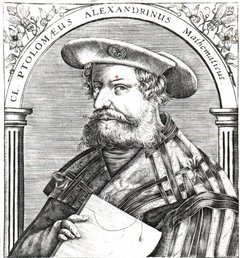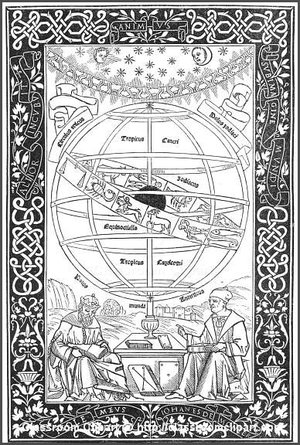Ptolemy
|
|

Claudius Ptolemaeus (Greek: Κλαύδιος Πτολεμαῖος; c. 85 – c. 165), known in English as Ptolemy, was a Greek geographer, astronomer, and astrologer who probably lived and worked in Alexandria in Egypt.
Ptolemy was the author of two important scientific treatises. One is the astronomical treatise that is now known as the Almagest (in Greek Η μεγάλη Σύνταξις, "The Great Treatise"). It was preserved, like most of Classical Greek science, in Arabic manuscripts (hence its familiar name) and only made available in Latin translation (by Gerard of Cremona) in the 12th century.
In this work, one of the most influential books of Antiquity, Ptolemy compiled the astronomical knowledge of the ancient Greek and Babylonian world; he relied mainly on the work of Hipparchus of three centuries earlier. Ptolemy formulated a geocentric model (see: Ptolemaic system) of the solar system which remained the generally accepted model in the Western and Arab worlds until it was superseded by the heliocentric solar system of Copernicus. Likewise his computational methods (supplemented in the 12th Century with the Arabic computational 'Tables of Toledo') were of sufficient accuracy to satisfy the needs of astronomers, astrologers and navigators, until the time of the great explorations. They were also adopted in the Arab world and in India. The Almagest also contains a star catalogue, which is probably an updated version of a catalogue created by Hipparchus. Its list of 48 constellations is ancestral to the modern system of constellations, but unlike the modern system they did not cover the whole sky.
Ptolemy's other main work is his Geography. This too is a compilation, of what was known about the world's geography in the Roman empire at his time. He relied mainly on the work of an earlier geographer, Marinos of Tyre, and on gazetteers of the Roman and ancient Persian empire, but most of his sources beyond the perimeter of the Empire were unreliable.
The first part of the Geography is a discussion of the data and of the methods he used. Like with the model of the solar system in the Almagest, Ptolemy put all this information into a grand scheme. He assigned coordinates to all the places and geographic features he knew, in a grid that spanned the globe. Latitude was measured from the equator, as it is today, but Ptolemy preferred to express it in the length of the longest day rather than degrees of arc (the length of the midsummer day increases from 12h to 24h as you go from the equator to the polar circle). He put the meridian of 0 longitude at the most western land he knew, the Canary Islands.
Ptolemy also devised and provided instructions on how to create maps both of the whole inhabited world and of the Roman provinces. In the second part of the Geography he provided the necessary topographic lists, and captions for the maps. His oikoumen" spanned 180 degrees of longitude from the Canary islands in the Atlantic Ocean to China, and about 80 degrees of latitude from the Arctic to the East-indies and deep into Africa; Ptolemy was well aware that he knew about only a quarter of the globe.
The maps in surviving manuscripts of Ptolemy's Geography however, date only from about 1300, after the text was rediscovered by Maximus Planudes.
Maps based on scientific principles had been made since the time of Eratosthenes (3rd century BC), but Ptolemy invented improved projections. It is known that a world map based on the Geography was on display in Autun (France) in late Roman times. In the 15th century Ptolemy's Geographia began to be printed with engraved maps; an edition printed at Ulm in 1482 was the first one printed north of the Alps. The maps look distorted as compared to modern maps, because Ptolemy's data were inaccurate. One reason is that Ptolemy estimated the Earth too small: while Eratosthenes found 700 stadia for a degree on the globe, in the Geographia Ptolemy uses 500 stadia. It is not certain if these geographers used the same stadion, but if we assume that they both stuck to the traditional Attic stadion of about 185 meters, then the older estimate is 1/6 too large, and Ptolemy's value is 1/6 too small. Because Ptolemy derived most of his topographic coordinates by converting measured distances to angles, his maps get distorted. So his values for the latitude were in error by up to 2 degrees. For longitude this was even worse, because there was no reliable method to determine geographic longitude; Ptolemy was well aware of this. It remained a problem in geography until the invention of chronometers at the end of the 18th century AD. It must be added that his original topographic list cannot be reconstructed: the long tables with numbers were transmitted to posterity through copies containing many scribal errors, and people have always been adding or improving the topographic data: this is a testimony of the persistent popularity of this influential work.
In his Optics, a work which survives only in a poor Arabic translation, he writes about properties of light, including reflection, refraction and colour. His other works include Planetary Hypothesis, Planisphaerium and Analemma.
| Contents |
Ptolemy and astrology
Ptolemy's treatise on astrology, the Tetrabiblos, was the most popular astrological work of antiquity and also enjoyed great influence in the Islamic world and the medieval Latin West. The Tetrabiblos is an extensive and continually reprinted treatise on the ancient priciples of astrology in four books (Greek tetra means "four", biblos is "book"). That it did not quite attain the unrivalled status of the Syntaxis was perhaps because it did not cover some popular areas of the subject, particularly horary astrology (interpreting astrological charts for a particular moment to determine the outcome of a course of action to be initiated at that time), electional astrology, and medical astrology. The great popularity that the Tetrabiblos did possess might be attributed to its nature as an exposition of the art of astrology and as a compendium of astrological lore, rather than as a manual. It speaks in general terms, avoiding illustrations and details of practice. Ptolemy was concerned to defend astrology by defining its limits, compiling astrological data that he believed was reliable and dismissing practices (such as considering the numerological significance of names) that he believed to be without sound basis.
Much of the content of the Tetrabiblos may well have been collected from earlier sources; Ptolemy's achievement was to order his material in a systematic way, showing how the subject could, in his view, be rationalised. It is, indeed, presented as the second part of the study of astronomy of which the Syntaxis was the first, concerned with the influences of the celestial bodies in the sublunar sphere. Thus explanations of a sort are provided for the astrological effects of the planets, based upon their combined effects of heating, cooling, moistening, and drying.
Ptolemy's astrological outlook was practical: astrology was like medicine; conjectural, because of the many variable factors to be taken into account: the race, country, upbringing, and so forth, of the individual. Some events are fated, others are not, and some occur as the result of general circumstances, not those of the individual.
Template:ConstellationsListedByPtolemy
Ptolemy and music
Ptolemy also wrote an influential work Harmonics on music theory. After criticizing the approaches of his predecessors, Ptolemy argued for basing musical intervals on mathematical ratios (in contrast to the followers of Aristoxenus) backed up by empirical observation (in contrast to the overly-theoretical approach of the Pythagoreans). He presented his own divisions of the tetrachord and the octave, which he derived with the help of a monochord. Ptolemy's astronomical interests also appeared in a discussion of the music of the spheres.
Named after Ptolemy
References
- Berggren, J. Lennart and Jones, Alexander. 2000. Ptolemy's Geography: An Annotated Translation of the Theoretical Chapters. Princeton University Press. Princeton and Oxford. ISBN: 0-691-01042-0.
- Stevenson, Edward Luther. Trans. and ed. 1932. Claudius Ptolemy: The Geography. New York Public Library. Reprint: Dover, 1991. (This is the only complete English translation of Ptolemy's most famous work. Unfortunately, it is marred by numerous mistakes and the placenames are given in Latinised forms, rather than in the original Greek).
External links
Primary sources
- Ptolemy's Tetrabiblos at LacusCurtius (http://penelope.uchicago.edu/Thayer/E/Roman/Texts/Ptolemy/Tetrabiblos/home.html) (English translation, with introductory material)
- Ptolemy's Geography at LacusCurtius (http://penelope.uchicago.edu/Thayer/E/Gazetteer/Periods/Roman/_Texts/Ptolemy/home.html) (English translation, incomplete)
Secondary material
- Ptolemy at SkyScript (http://www.skyscript.co.uk/ptolemy.html) - The Life and Work of Ptolemy
- Alexander Jones, "Ptolemy and his Geography" (http://www.chass.utoronto.ca/~ajones/ptolgeog/)
- Ptolemy biography (http://obs.nineplanets.org/psc/theman.html) (Bill Arnett's site)
- Ptolemy's Geography of Asia (http://wwwuser.gwdg.de/~fhasele/ptolemaeus/index.html) - Selected problems of Ptolemy's Geography of Asia (currently in German)
- Ptolemy's Geography of Northwestern Europe (http://www.fiks.de/rom/index.htm?rom10.htm)

